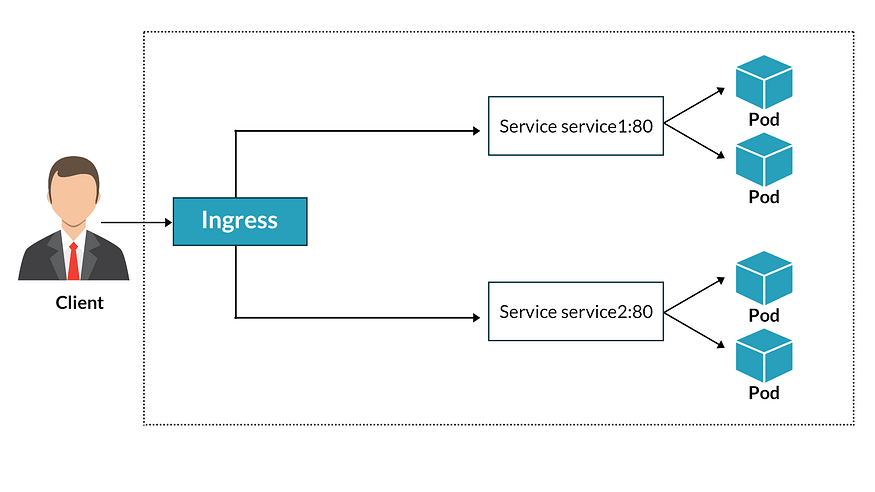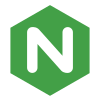When it comes to Kubernetes workloads, accessing your apps outside the cluster can be a bit of a puzzle. Kubernetes offers a couple of solutions, like manually setting up NodePort or LoadBalancer services. But beware! These methods can be a real maze, with added manual tasks and a tangled web of non-standard ports.

When working with HTTP/HTTPS traffic, an ingress allows you to manage external access to the applications running in your cluster by configuring ingress resources. However, for the ingress to work, you also need an ingress controller, a component responsible for the routing specified by your ingress resources.
In this journey, we’ll explore the fascinating realm of Kubernetes ingress, unveiling the intricacies of configuration. Along the way, we’ll equip you with advanced insights to elevate your Kubernetes ingress game and provide a glimpse into some of the popular ingress controllers
What Are Ingress Controllers?
In the Kubernetes universe, knowing the difference between ingress resources and ingress controllers is the key to mastering routing. Ingress resources lay down the rules, directing network traffic to specific services based on defined conditions. Meanwhile, the ingress controller plays the role of a traffic conductor, expertly handling these rules and ensuring traffic flows seamlessly as instructed. Get ready to decode the intricacies of Kubernetes routing with us!!

Kubernetes Ingress Controllers in Action
To get started with Kubernetes ingress, you first need an ingress controller. There are numerous providers that can fulfill this role, from general options like Nginx, Traefik, and HAProxy to cloud-provider-specific offerings. The official Kubernetes documentation contains a list of third-party controllers you can refer to for more details.
If you are trying out Kubernetes locally to experiment with ingress, there are several simple ways to get started. The official documentation has a guide that uses minikube with an ingress add-on. There is a similar add-on for the comparable MicroK8s project. Both of these add-ons will add an Nginx ingress controller to your cluster. If you’d prefer to add an ingress controller to an existing cluster, the official documentation for the Nginx ingress controller provides manifests that you can use to deploy the controller for a wide range of setups.
Once your cluster has an ingress controller, you can test it by creating ingress resources.
The following is an example manifest taken from the Kubernetes documentation that defines a simple ingress resource to route traffic to a test HTTP service:
apiVersion: networking.k8s.io/v1
kind: Ingress
metadata:
name: nginx-test
spec:
tls:
- hosts:
- foo.bar.com
# This assumes tls-secret exists and the SSL
# certificate contains a CN for foo.bar.com
secretName: tls-secret
ingressClassName: nginx
rules:
- host: foo.bar.com
http:
paths:
- path: /
pathType: Prefix
backend:
# This assumes http-svc exists and routes to healthy endpoints
service:
name: http-svc
port:
number: 80
This resource handles routing and SSL/TLS termination at the ingress level, meaning unencrypted HTTP traffic will be forwarded to the pods behind the service. As noted in the documentation, load balancing isn’t currently configurable at the ingress level beyond any settings inherent to the specific ingress controller you use. If you want to implement load balancing for your applications, you can do so at the service level.
Taking Ingress to the Next Level: Advanced Tips
Introducing ingress to your cluster allows you to build more robust applications, but it can also introduce additional complexity that you must be mindful of. This section covers several tips and best practices to keep in mind. Some are specific to ingress, while others apply to Kubernetes in general. These practices will help you manage the growing complexity of your cluster.
Use Ingress for SSL/TLS Termination
When designing your system, you need to consider where your SSL/TLS connections will terminate. While you can pass the encrypted traffic through to your pods for processing, this introduces unnecessary complexity to your application. A more efficient solution involves letting your ingress handle SSL/TLS termination. Using this approach means that your application pods don’t need to deal with the overhead and complexity of SSL/TLS-encrypted traffic. The ingress controller will send unencrypted HTTP traffic internally to the pods once the SSL/TLS connection is terminated. This way, you get all the benefits of SSL/TLS while traversing the internet without needing to spread the complexity of handling encryption throughout your pods.
Use a Wildcard DNS Record
You can use a wildcard DNS record to route all subdomains of a given domain to the same IP address. If the IP address used for this DNS record resolves to your Kubernetes ingress, you can use subdomain names as part of your ingress routing rules. This offers significant flexibility, as you can quickly assign distinct addresses to new services without needing to create new DNS records. For example, this could be useful if you want to dynamically create an instance of your application each time a developer makes a pull request on your version control system. You could use the pull request number assigned by the version control system as the subdomain name and route any requests to that hostname to an instance of your application dedicated to testing the changes in that pull request.
Use IngressClass
You are not limited to only one ingress controller in your cluster. If you need to run multiple ingress controllers — for instance, if your cloud provider includes one by default but you’d like to use Nginx — Kubernetes facilitates this through the IngressClass concept.
Typically, you don’t need to specify an ingressClassName on your ingress resources if you only have one ingress controller. If you have multiple, however, you can define IngressClass resources that designate a name for a particular controller. This name can then be referenced by your ingress resources to indicate that a specific controller should handle them. You can see an example of an IngressClass resource (taken from the official documentation) below:
apiVersion: networking.k8s.io/v1
kind: IngressClass
metadata:
name: external-lb
spec:
controller: example.com/ingress-controller
parameters:
apiGroup: k8s.example.com
kind: IngressParameters
name: external-lb
Use Namespaces
Namespaces in Kubernetes give you a mechanism to separate your resources into different logical groups, making things more manageable. If you are dealing with multiple applications in your cluster that make sense to separate logically, it’s generally a good idea to leverage namespaces. However, if you do, it’s essential to know how they interact with ingress. Your ingress controller will be deployed in a specific namespace — often one dedicated to it — but will be able to handle resources from all namespaces. This means that you can use a single ingress controller for all of your namespaces, while your ingress resources will be spread across various namespaces. Typically, for cohesion purposes, you should have ingress resources residing in the same namespace as the services they point to.
Keep Configuration as Code
While it’s possible to use Kubernetes in an entirely ephemeral manner by creating all your resources with kubectl, this is not the best way to manage things, as it can make it more difficult to alter or recreate your running configuration if you ever need to. It’s generally accepted that keeping your Kubernetes configuration as code is best practice, at least for any long-lived components that you want to keep running. This means defining your resources in manifests and applying the manifests using kubectl. This same principle applies to ingress; you can define your ingress resources (and the resources that compose your ingress controller) in manifests, making it much easier to manage, tweak, and deploy your applications.
Comparison of Controllers
There are many choices when it comes to ingress controllers. Each major cloud provider has its own implementation, and there are many more third-party options. This section briefly examines three popular non-cloud-provider-specific options, including their features, benefits, and limitations.

Nginx
The Nginx ingress controller is unsurprisingly built on top of the Nginx web server, and as such, it’ll offer a familiar experience if you’ve worked with the web server before. The Nginx controller is often treated as something of a default by online resources talking about Kubernetes ingress, likely for this reason, in addition to the fact that it’s supported and maintained by the Kubernetes project.
Features
Includes a wide selection of supported annotations for configuring behavior
Supports SSL/TLS termination
Supports a variety of load balancing algorithms
Allows URL rewriting and request/response modifications
Offers rate limiting and IP allowlisting/blocklisting
Benefits
Mature and widely used, with a strong community
Well-documented and easy to set up
Can handle high-traffic loads
Limitations
Some advanced features are locked behind the enterprise offering, Nginx Plus
Advanced configuration beyond what’s afforded in the annotations can be challenging
Limited support for authentication methods
Lack of support for health checks to prevent traffic from being sent to unhealthy instances.
Traefik
Traefik is newer than Nginx but has already amassed a significant following. Originally designed to be a simple but capable reverse proxy and load balancer for microservice applications, Traefik is a great fit as a Kubernetes ingress controller.
Features
Excellent built-in support for Let’s Encrypt for HTTPS
Traffic mirroring allows you to mirror incoming traffic to different destinations for testing or monitoring
Circuit breakers and automatic retries can help improve the resilience of your application
Health checks can be performed on backend services to ensure only healthy instances receive traffic
Benefits
Easy configuration for basic and everyday use cases
Community-driven and open source, so updates are reasonably frequent and transparent
Excellent authentication support
Limitations
Not as well-documented as Nginx due to being newer on the scene
Advanced configurations may be complex due to more limited fine-grained controls.
Fairly limited load balancing algorithm support
HA Proxy
HA Proxy ingress controller is another implementation you should consider. HAProxy is a well-established reverse proxy and load balancer built with a focus on reliability and performance.
Features
SSL/TLS termination means backend services don’t have to deal with the overhead of encrypted traffic.
Rate limiting can be applied to prevent abuse or control access to specific services.
Session persistence ensures that traffic from the same client is directed to the same backend servers
Health checks can be performed on backend services to ensure only healthy instances receive traffic.
Benefits
HAProxy is generally regarded as being highly performant, making it a good choice for high-traffic environments.
With a strong focus on reliability, HAProxy is a solid choice for important production workloads.
Limitations
Currently no HTTP/3 support
Relatively limited load-balancing algorithm support
Limited/basic authentication support
Ultimately, each of these ingress controllers offers similar features, and which one is best for you will depend on your use case.
Wrapping Up
In this article, we delved into the world of Kubernetes ingress and controllers, spilling the beans on tips, best practices, and the top three ingress controllers. By harnessing Kubernetes ingress, you transform your application’s routing and HTTP management into a breeze. Say goodbye to scattered concerns like routing, rate limiting, SSL/TLS termination, and authentication — all seamlessly managed in one dedicated hub, freeing your cluster to excel at its strengths.
If you’re ready to take your ingress management to the next level, consider exploring cert-manager, a powerful tool designed to streamline your cluster’s SSL/TLS certificate management. By integrating cert-manager with your ingress controller, you can simplify the process of obtaining and utilizing certificates for enhanced security and trust in your applications.
Armed with this insight, you’re primed to supercharge your Kubernetes infrastructure, skillfully steering the traffic of your applications with confidence, scalability, and peak efficiency.
“In closing, as you venture further into the captivating world of Kubernetes, remember that every challenge you embrace is a chance to learn and grow. Happy learning with K8s, and rest assured, I’m here to assist you every step of the way.
This journey through Kubernetes and DevOps is not just about mastering technology; it’s about shaping the future. It’s about optimizing, automating, and empowering your infrastructure to do remarkable things. So, may your path be lined with continuous improvement, seamless deployments, and endless innovation. The world of DevOps is vast, and your potential is limitless. Here’s to the exciting road ahead!!!…” 🚀🔗💡